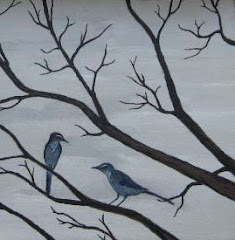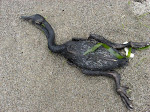On Saturday, Sarah and I led a Birdathon team called
The Murre The Merrier. Birdathon is the Audubon Society of Portland's largest fund raising event of the year and this was our second year as trip leaders.
In twelve hours, we traveled 200 miles through two counties and identified exactly 100 species of birds!
The day started at 7:00 in the parking lot of the Hillsboro Public Library. After a brief introduction, we began by birding Dawson Creek Park, which is adjacent to the library. The day’s first birds included Bushtits, Western Scrub Jays, and American Kestrels. Red-winged Blackbirds displayed near the ponds and a pair of Canada Geese swam by with their newly hatched brood of goslings.

Great Blue Herons were still perched in their evening roost tree near a small flock of Cedar Waxwings. The participants made their way to a bluff above Dawson Creek where they viewed an Acorn Woodpecker colony.

On top of the bluff, I aimed my scope on a broken tree housing a Great Horned Owl nest.

As expected, two downy nestlings stared back at us with their big yellow eyes. The rest of the birders oohed and awed as they had their looks at the growing owlets. A few Western Tanagers and a Western Wood Pewee were spotted in nearby trees, ending the visit on a great note.
Pleased with the the 33 species observed at Dawson Creek, everyone loaded into the van and proceeded to Killin Wetlands, west of Banks. Common Yellowthroats and Marsh Wrens sang loudly as we listened for American Bitterns and Virginia Rails. A couple of birders were lucky enough to hear a bittern and a few more caught a quick glimpse of a rail. On the way back to the van, the group had a few good looks at Yellow-rumped, Wilson’s, and Yellow Warblers. They listened for a few more species, then loaded up and headed into the Coast Range.
After a quick detour for gas station Cliff Swallows, the next stop was the Tillamook Forest Center.

The group was treated to a pair of American Dippers nesting under a footbridge crossing the Wilson River.

Atop the bridge, several participants viewed Chestnut-backed Chickadees and a Common Merganser flyby.
The group drove through a few rain showers as they exited the Coast Range and entered the Tillamook Valley. By the time the van stopped at Tillamook Bay, the rain was replaced by gusting winds.

Undeterred, everyone put on their wind-breakers, gloves, and hats and walked along the Bayocean spit. A large group of shorebirds could be seen in the mudlfats, but only a few species, Semipalmated Plover, Black Turnstone, and Dunlin could be identified. From the spit, the group could also see a flock of Brant, an immature Bald Eagle, and several species of dabbling ducks.
The wind slowed by the time we finished lunch at Cape Meares. The trip lived up to its name when we found thousands of Common Murres preparing to nest on island tops and ledges below the viewing areas.

Pelagic Cormorants were sitting on their platform nests and a few Pigeon Guillemots could be seen floating in the waves. A Peregrine Falcon made a brief, crowd pleasing appearance, flying up and down the cliff walls where it usually nests. After the falcon disappeared, the group hiked down to the lighthouse and saw an amazing number of birds from the southern side of the cape.

Thousands of murres were floating in rafts and a steady stream of Pacific Loons flew northward just above their heads. Sarah spotted a lone Red-necked Grebe and a few chattery Black Oystercatchers passed by. A small group of Brown Pelicans flew into view and sat on the water near floating Surf Scoters.
As the sun reappeared, the crew reluctantly left Cape Meares and drove south to Netarts Bay. The water in the bay was choppy and few birds could be seen, so the van proceeded on to Sand Lake, a saltwater estuary north of Pacific City. Sarah and I led everyone through a small forest on Whalen Island and onto a tidal flat.

When scopes were set up, participants could see a small flock of White-fronted Geese, several Whimbrels, and huge flock of small shorebirds across the water. Our tripods and feet began sinking into the mud, so everyone retreated to higher ground. Before loading in the van, we noticed a singing female Purple Finch and a calling male Brown-headed Cowbird.
The last stop on the coast was Pacific City. Everyone had thirty minutes to walk the beach or visit the local coffee shop. Most opted for coffee, then returned to the beach. Those that stayed on the beach were treated to views of Bonaparte’s Gulls in black-headed breeding plumage fluttering tern-like above the heads of surfing humans.
As everyone loaded into the van, Sarah counted up the list of birds seen so far and reported that the total had reached 98. Everyone agreed that we could not return to Hillsboro short of 100. A few brief listening stops near the Nestucca River did not produce any new species. A few miles later, I pulled the van into a rest area along the Tillamook River. The weather was as nice as it had been all day and the birds seemed inspired to get active. Among many previously identified warblers, I spotted a Warbling Vireo that remained in view long enough for many to see. With one more bird to go, everyone was eager to spot a new species. A silent Empidonax flycatcher perched above us, but we lacked the confidence to identify its species. A few minutes later, Sarah spotted some motion through the trees and realized it was a Spotted Sandpiper walking along the stream. A few more people confirmed it, and the group realized that they had reached 100!
The Murre The Merrier Bunch headed home with the satisfaction of reaching their 100 species goal. Everyone had a great time raising money fro a great cause, learning about bird, and getting to know one another.

As the sun began to set, participants unloaded the van, ready to get some sleep and start planning next year’s trip to find the species that got away.
Birds found:Pacific Loon
Common Loon
Red-necked Grebe
Brown Pelican
Double-crested Cormorant
Pelagic Cormorant
American Bittern
Great Blue Heron
Greater White-fronted Goose
Canada Goose
Brant
Wood Duck
American Wigeon
Mallard
Blue-winged Teal
Cinnamon Teal
Northern Shoveler
Northern Pintail
Green-winged Teal
Ring-necked Duck
Lesser Scaup
Surf Scoter
Bufflehead
Hooded Merganser
Common Merganser
Red-breasted Merganser
Turkey Vulture
Bald Eagle
Cooper’s Hawk
Red-tailed Hawk
American Kestrel
Peregrine Falcon
Virginia Rail
Semipalmated Plover
Killdeer
Black Oystercatcher
Spotted Sandpiper
Whimbrel
Black Turnstone
Western Sandpiper
Dunlin
Long-billed Dowitcher
Bonaparte’s Gull
Ring-billed Gull
Western Gull
Glaucous-winged Gull
Caspian Tern
Common Murre
Pigeon Guillemot
Rock Dove
Band-tailed Pigeon
Mourning Dove
Great Horned Owl
Rufous Hummingbird
Belted Kingfisher
Acorn Woodpecker
Downy Woodpecker
Northern Flicker
Western Wood Pewee
Warbling Vireo
Steller’s Jay
Western Scrub Jay
American Crow
Common Raven
Tree Swallow
Violet-green Swallow
Cliff Swallow
Barn Swallow
Black-capped Chickadee
Chestnut-backed Chickadee
Bushtit
Brown Creeper
Bewick’s Wren
Winter Wren
Marsh Wren
American Dipper
Golden-crowned Kinglet
Ruby-crowned Kinglet
American Robin
European Starling
Cedar Waxwing
Yellow Warbler
Yellow-rumped Warbler
Black-throated Gray Warbler
Common Yellowthroat
Wilson’s Warbler
Western Tanager
Spotted Towhee
Savannah Sparrow
Song Sparrow
White-crowned Sparrow
Golden-crowned Sparrow
Dark-eyed Junco
Red-winged Blackbird
Brewer’s Blackbird
Brown-headed Cowbird
Purple Finch
House Finch
American Goldfinch
House Sparrow
Birds that got away (to be found next year)Pied-billed Grebe
Brandt’s Cormorant
Great Egret
Gadwall
California Quail
Sora
Common Snipe
Tufted Puffin
Vaux’s Swift
Anna’s Hummingbird
Red-breasted Sapsucker
Hairy Woodpecker
Pileated Woodpecker
Pacific Slope Flycatcher
Hutton’s Vireo
Gary Jay
Red-breasted Nuthatch
White-breasted Nuthatch
Western Bluebird
Swainson’s Thrush
Orange-crowned Warbler
Black-headed Grosbeak
Red Crossbill






















































